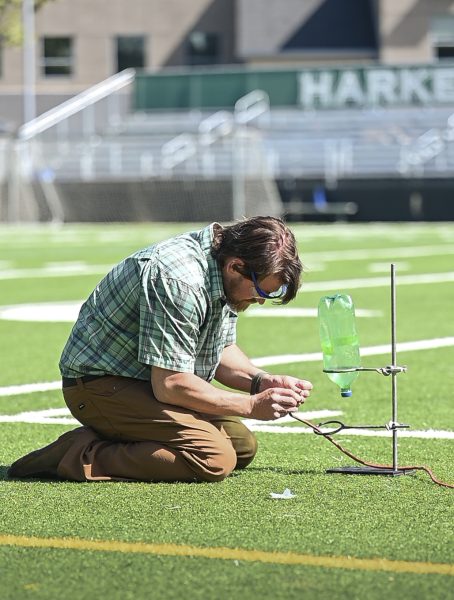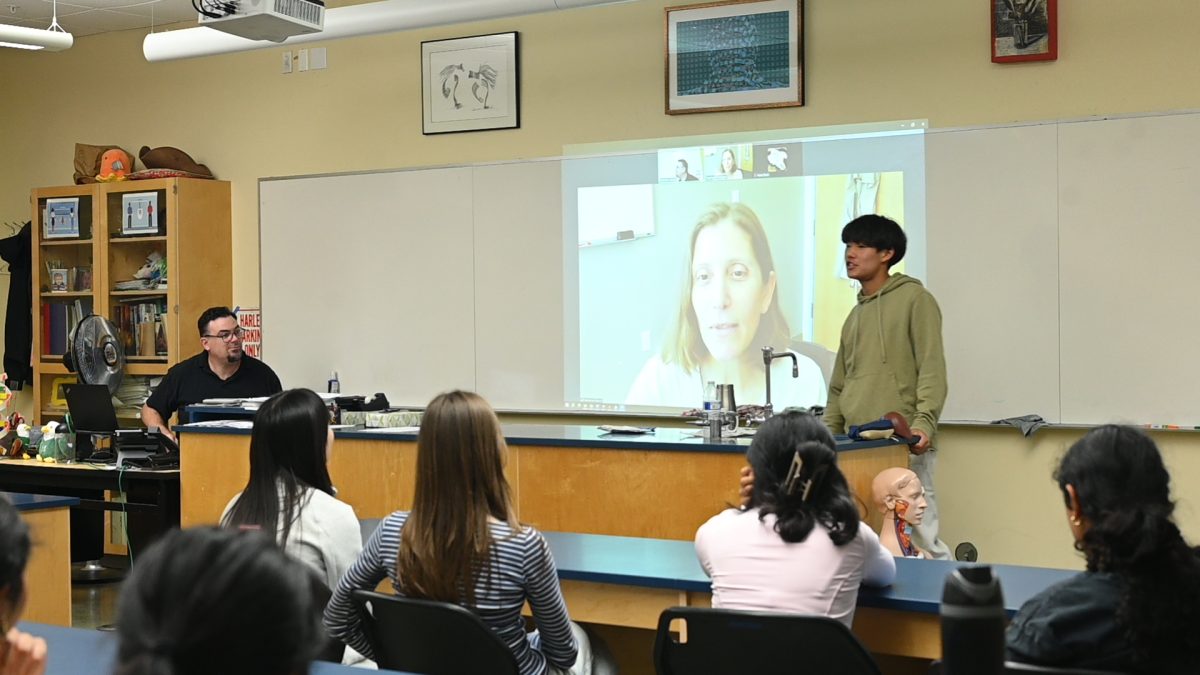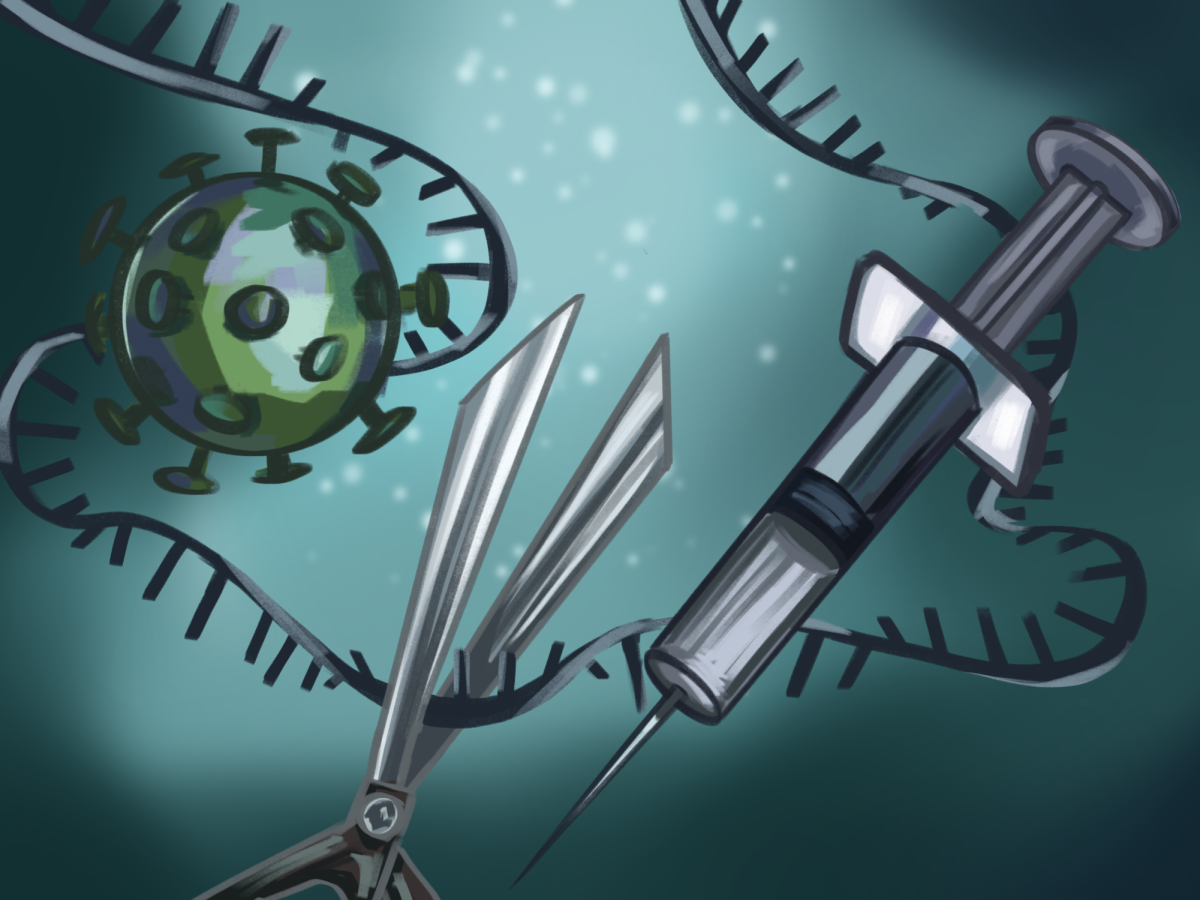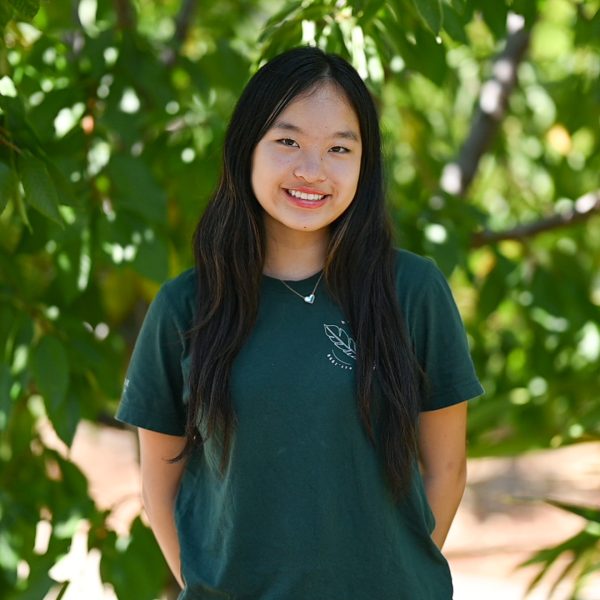Students from Honors and AP Chemistry classes closed out the year with a hands-on hydrogen rocket lab on Davis Field on Monday and Tuesday. Some classes also conducted an instant ice cream experiment, enjoying their homemade desserts while launching their rockets.
In the hydrogen rocket lab, students filled 2-liter plastic bottles with hydrogen and oxygen gas using the water displacement method. The students reacted calcium metal with water to create the hydrogen gas, and they decomposed hydrogen peroxide with a potassium iodide catalyst to produce oxygen gas. When the students sparked their bottles with the press of a button, the reaction produced large amounts of water vapor due to the high temperature. The bottles either exploded to the side from internal pressure or shot up into the air, with some even reaching twenty feet in height.

The hydrogen rocket lab provided students with a hands-on opportunity to apply knowledge gained over the course of the year, whether that be through filling the bottles with gas or calculating the necessary amounts of water for the reaction. Compared to typical chemistry labs, the hydrogen rocket lab stood out by allowing students to witness the principles of combustion and gas behavior in a more dramatic way.
“I liked that this lab was different from anything we’ve ever done before,” Honors Chemistry student MacEnzie Blue (10) said.
Many students brought plastic soda bottles for the experiment, but Honors Chemistry student Christy Ma (10) brought an olive oil bottle, which produced a different, unique result.
“Because [my bottle] wasn’t a soda bottle and the material wasn’t the same, it exploded through the bottom and caught on fire, which was really cool,” Christy said. “It was fun getting to see all the bottles fly off really far.”

AP Chemistry students then applied their knowledge of thermodynamics to create instant ice cream. They added flavored condensed milk to a small bag and then put the small bag inside a larger ziploc bag with ice cubes. Salt, added to the larger bag, lowered the melting point of the ice, catalyzing a change in physical state for the milk inside the inner bag. To allow the milk to freeze more quickly, the students shook the bags of ice and tossed them back and forth in fun games of catch.
“This lab uses colligative properties, which is part of the textbook but has been pulled out of the AP exam for time reasons,” Brown said. “We’re out here on the field anyways, so we fit the lab in because it’s a nice way to look forward to summer.”


















![“[Building nerf blasters] became this outlet of creativity for me that hasn't been matched by anything else. The process [of] making a build complete to your desire is such a painstakingly difficult process, but I've had to learn from [the skills needed from] soldering to proper painting. There's so many different options for everything, if you think about it, it exists. The best part is [that] if it doesn't exist, you can build it yourself," Ishaan Parate said.](https://harkeraquila.com/wp-content/uploads/2022/08/DSC_8149-900x604.jpg)




![“When I came into high school, I was ready to be a follower. But DECA was a game changer for me. It helped me overcome my fear of public speaking, and it's played such a major role in who I've become today. To be able to successfully lead a chapter of 150 students, an officer team and be one of the upperclassmen I once really admired is something I'm [really] proud of,” Anvitha Tummala ('21) said.](https://harkeraquila.com/wp-content/uploads/2021/07/Screen-Shot-2021-07-25-at-9.50.05-AM-900x594.png)







![“I think getting up in the morning and having a sense of purpose [is exciting]. I think without a certain amount of drive, life is kind of obsolete and mundane, and I think having that every single day is what makes each day unique and kind of makes life exciting,” Neymika Jain (12) said.](https://harkeraquila.com/wp-content/uploads/2017/06/Screen-Shot-2017-06-03-at-4.54.16-PM.png)








![“My slogan is ‘slow feet, don’t eat, and I’m hungry.’ You need to run fast to get where you are–you aren't going to get those championships if you aren't fast,” Angel Cervantes (12) said. “I want to do well in school on my tests and in track and win championships for my team. I live by that, [and] I can do that anywhere: in the classroom or on the field.”](https://harkeraquila.com/wp-content/uploads/2018/06/DSC5146-900x601.jpg)
![“[Volleyball has] taught me how to fall correctly, and another thing it taught is that you don’t have to be the best at something to be good at it. If you just hit the ball in a smart way, then it still scores points and you’re good at it. You could be a background player and still make a much bigger impact on the team than you would think,” Anya Gert (’20) said.](https://harkeraquila.com/wp-content/uploads/2020/06/AnnaGert_JinTuan_HoHPhotoEdited-600x900.jpeg)

![“I'm not nearly there yet, but [my confidence has] definitely been getting better since I was pretty shy and timid coming into Harker my freshman year. I know that there's a lot of people that are really confident in what they do, and I really admire them. Everyone's so driven and that has really pushed me to kind of try to find my own place in high school and be more confident,” Alyssa Huang (’20) said.](https://harkeraquila.com/wp-content/uploads/2020/06/AlyssaHuang_EmilyChen_HoHPhoto-900x749.jpeg)











